Fundamental geometric operations for B-Splines#
Having more control on a curve, adding new control points, can be done in two different ways:
insert new knots
elevate the polynomial degree
In general, one way need to use both approaches. For each strategy, we shall consider one algorithm.
Remark: In this notebook we only use B-Splines curves, but similar functions are also available for NURBS.
# needed imports
import numpy as np
import matplotlib.pyplot as plt
Knot insertion#
Assuming an initial B-Spline curve defined by:
its degree \(p\)
knot vector \(T=(t_i)_{0\leqslant i \leqslant n + p + 1}\)
control points \((\mathbf{P}_i)_{ 0 \leqslant i \leqslant n}\)
We are interested in the new B-Spline curve as the result of the insertion of the knot \(t\), \(m\) times (with a span \(j\), i.e. \(t_j \leqslant t < t_{j+1}\)).
After such operation, the degree is remain unchanged, while the knot vector is enriched by \(t\), \(m\) times. The aim is then to compute the new control points \((\mathbf{Q}_i)_{ 0 \leqslant i \leqslant n + m}\)
For this purpose we use the DeBoor algorithm:
where
with
The following python function implements the previous algorithm.
# import the knot insertion function
from bsplines_utilities import insert_knot_bspline_curve
From now on, we shall also use the following function to plot curves and their control points:
from bsplines_utilities import plot_curve
Examples
def example_1(times=1):
knots = [0., 0., 0., 0., 1., 1., 1., 1.]
degree = 3
n = len(knots) - degree - 1
P = np.zeros((n, 2))
P[:, 0] = [1., 1., 0., -1.]
P[:, 1] = [0., 1., 1., 0.]
plot_curve(knots, degree, P, with_ctrl_pts=False)
# we don't plot the first and last points
# they will be plotted later
for i in range(1, n-1):
x,y = P[i,:]
plt.text(x+0.05,y+0.05,'$\mathbf{P}_{' + str(i) + '}$')
t = 0.5
knots, degree, P = insert_knot_bspline_curve(knots, degree, P, t, times=times)
plot_curve(knots, degree, P, color='r', label='Q', with_ctrl_pts=False)
# we don't plot the first and last points
# they will be plotted later
n = len(knots) - degree - 1
for i in range(1, n-1):
x,y = P[i,:]
plt.text(x+0.05,y+0.05,'$\mathbf{Q}_{' + str(i) + '}$')
# plot endpoints
for i in [0, n-1]:
x = P[i,0] ; y = P[i,1]
if i == 0:
Pi = '\mathbf{P}_{' + str(i) + '}'
elif i == n-1:
Pi = '\mathbf{P}_{' + str(i-1) + '}'
Qi = '\mathbf{Q}_{' + str(i) + '}'
text = '${Pi} = {Qi}$'.format(Pi=Pi, Qi=Qi)
plt.text(x+0.05,y+0.05,text)
example_1(times=1)
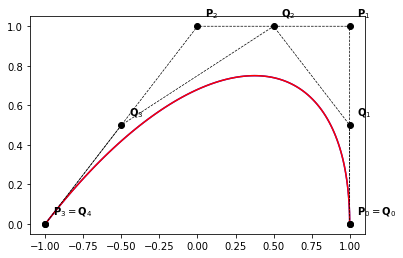
example_1(times=2)

example_1(times=3)
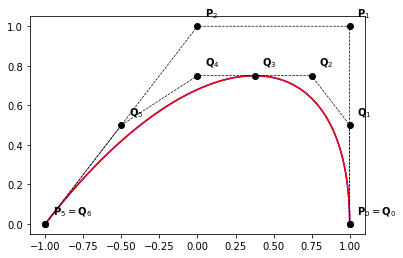
def example_2a(nt = 3):
knots = [0., 0., 0., 0., 1., 1., 1., 1.]
degree = 3
n = len(knots) - degree - 1
P = np.zeros((n, 2))
P[:, 0] = [1., 1., 0., -1.]
P[:, 1] = [0., 1., 1., 0.]
plot_curve(knots, degree, P, with_ctrl_pts=False)
# we don't plot the first and last points
# they will be plotted later
for i in range(1, n-1):
x,y = P[i,:]
plt.text(x+0.05,y+0.05,'$\mathbf{P}_{' + str(i) + '}$')
ts = np.linspace(0., 1., nt+2)[1:-1]
for t in ts:
knots, degree, P = insert_knot_bspline_curve(knots, degree, P, t, times=1)
plot_curve(knots, degree, P, color='r', label='Q', with_ctrl_pts=False)
# we don't plot the first and last points
# they will be plotted later
n = len(knots) - degree - 1
for i in range(1, n-1):
x,y = P[i,:]
plt.text(x+0.05,y+0.05,'$\mathbf{Q}_{' + str(i) + '}$')
# plot endpoints
for i in [0, n-1]:
x = P[i,0] ; y = P[i,1]
if i == 0:
Pi = '\mathbf{P}_{' + str(i) + '}'
elif i == n-1:
Pi = '\mathbf{P}_{' + str(i-1) + '}'
Qi = '\mathbf{Q}_{' + str(i) + '}'
text = '${Pi} = {Qi}$'.format(Pi=Pi, Qi=Qi)
plt.text(x+0.05,y+0.05,text)
# curve after inserting [0.25 0.5 0.75]
example_2a(nt=3)

# curve after inserting [0.1 0.2 0.3 0.4 0.5 0.6 0.7 0.8 0.9]
example_2a(nt=9)
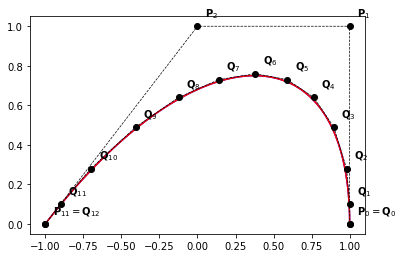
Order elevation#
There are also many algorithms for degree elevation of a B-Spline curve. In the sequel, we will be using the one developped by Huand, Hu and Martin (2005).
The previous algorithm is implemented by the following function
# import the degree elevation function
from bsplines_utilities import elevate_degree_bspline_curve
Example 1.
def example_1(m=1):
knots = [0., 0., 0., 0., 0.5, 1., 1., 1., 1.]
degree = 3
n = len(knots) - degree - 1
P = np.zeros((n, 2))
P[:, 0] = [1., 1., .5, -.5, -1.]
P[:, 1] = [0., .5, 1., .5, 0.]
plot_curve(knots, degree, P, with_ctrl_pts=False)
# we don't plot the first and last points
# they will be plotted later
for i in range(1, n-1):
x,y = P[i,:]
plt.text(x+0.05,y+0.05,'$\mathbf{P}_{' + str(i) + '}$')
knots, degree, P = elevate_degree_bspline_curve(knots, degree, P, m=1)
plot_curve(knots, degree, P, color='r', label='Q', with_ctrl_pts=False)
# we don't plot the first and last points
# they will be plotted later
n = len(knots) - degree - 1
for i in range(1, n-1):
x,y = P[i,:]
plt.text(x+0.05,y+0.05,'$\mathbf{Q}_{' + str(i) + '}$')
# plot endpoints
for i in [0, n-1]:
x = P[i,0] ; y = P[i,1]
if i == 0:
Pi = '\mathbf{P}_{' + str(i) + '}'
elif i == n-1:
Pi = '\mathbf{P}_{' + str(i-1) + '}'
Qi = '\mathbf{Q}_{' + str(i) + '}'
text = '${Pi} = {Qi}$'.format(Pi=Pi, Qi=Qi)
plt.text(x+0.05,y+0.05,text)
example_1()

Example 2.
def example_2(m=1):
knots = [0., 0., 0., 0., 0.5, 0.5, 1., 1., 1., 1.]
degree = 3
n = len(knots) - degree - 1
n_initial = n
P = np.zeros((n, 2))
P[:, 0] = [260., 100., 260., 420., 580., 420.]
P[:, 1] = [100., 260., 420., 420., 260., 100.]
plot_curve(knots, degree, P, with_ctrl_pts=False)
# we don't plot the first and last points
# they will be plotted later
for i in range(1, n-1):
x,y = P[i,:]
plt.text(x+0.05,y+0.05,'$\mathbf{P}_{' + str(i) + '}$')
knots, degree, P = elevate_degree_bspline_curve(knots, degree, P, m=m)
plot_curve(knots, degree, P, color='r', label='Q', with_ctrl_pts=False)
# we don't plot the first and last points
# they will be plotted later
n = len(knots) - degree - 1
for i in range(1, n-1):
x,y = P[i,:]
plt.text(x+0.05,y+0.05,'$\mathbf{Q}_{' + str(i) + '}$')
# plot endpoints
for i in [0, n-1]:
x = P[i,0] ; y = P[i,1]
if i == 0:
Pi = '\mathbf{P}_{' + str(i) + '}'
elif i == n-1:
Pi = '\mathbf{P}_{' + str(n_initial-1) + '}'
Qi = '\mathbf{Q}_{' + str(i) + '}'
text = '${Pi} = {Qi}$'.format(Pi=Pi, Qi=Qi)
plt.text(x+0.05,y+0.05,text)
example_2(m=1)

example_2(m=2)
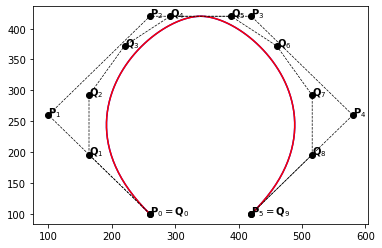
example_2(m=4)

example_2(m=8)
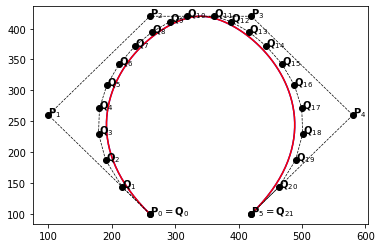
Translation#
Since B-Spline curves are invariant under affine transformations, whan translating a curve with a given displacement, the new curve has the same knot vector while the control points are obtained by applying the same translation to the initial ones.
The following function implements this utility
# import the translation of a B-Spline curve
from bsplines_utilities import translate_bspline_curve
def example_1():
knots = [0., 0., 0., 0., 1., 1., 1., 1.]
degree = 3
n = len(knots) - degree - 1
P = np.zeros((n, 2))
P[:, 0] = [1., 1., 0., -1.]
P[:, 1] = [0., 1., 1., 0.]
plot_curve(knots, degree, P)
knots, P = translate_bspline_curve(knots, P, [1., 1.5])
plot_curve(knots, degree, P, color='r', label='Q')
example_1()
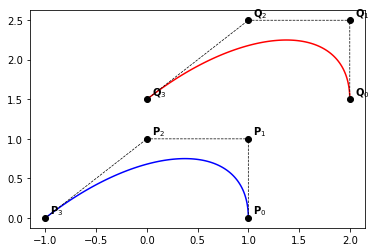
Rotation#
Rotating a B-Spline curve with an angle \(\theta\) is done by applying it on the control points, as for the translation algorithm.
The following function implements this utility.
# import the rotation of a B-Spline curve
from bsplines_utilities import rotate_bspline_curve
def example_1():
knots = [0., 0., 0., 0., 1., 1., 1., 1.]
degree = 3
n = len(knots) - degree - 1
P = np.zeros((n, 2))
P[:, 0] = [1., 1., 0., -1.]
P[:, 1] = [0., 1., 1., 0.]
plot_curve(knots, degree, P)
knots, P = rotate_bspline_curve(knots, P, np.pi/3., center=[-1.,0.])
plot_curve(knots, degree, P, color='r', label='Q')
example_1()

Homothetic transformation#
The following function implements a hmothetic transformation for B-Spline curves.
# import the homothetic transformation of a B-Spline curve
from bsplines_utilities import homothetic_bspline_curve
def example_1():
knots = [0., 0., 0., 0., 1., 1., 1., 1.]
degree = 3
n = len(knots) - degree - 1
P = np.zeros((n, 2))
P[:, 0] = [1., 1., 0., -1.]
P[:, 1] = [0., 1., 1., 0.]
plot_curve(knots, degree, P)
knots, P = homothetic_bspline_curve(knots, P, 0.5, center=[0.,0.])
plot_curve(knots, degree, P, color='r', label='Q')
example_1()

